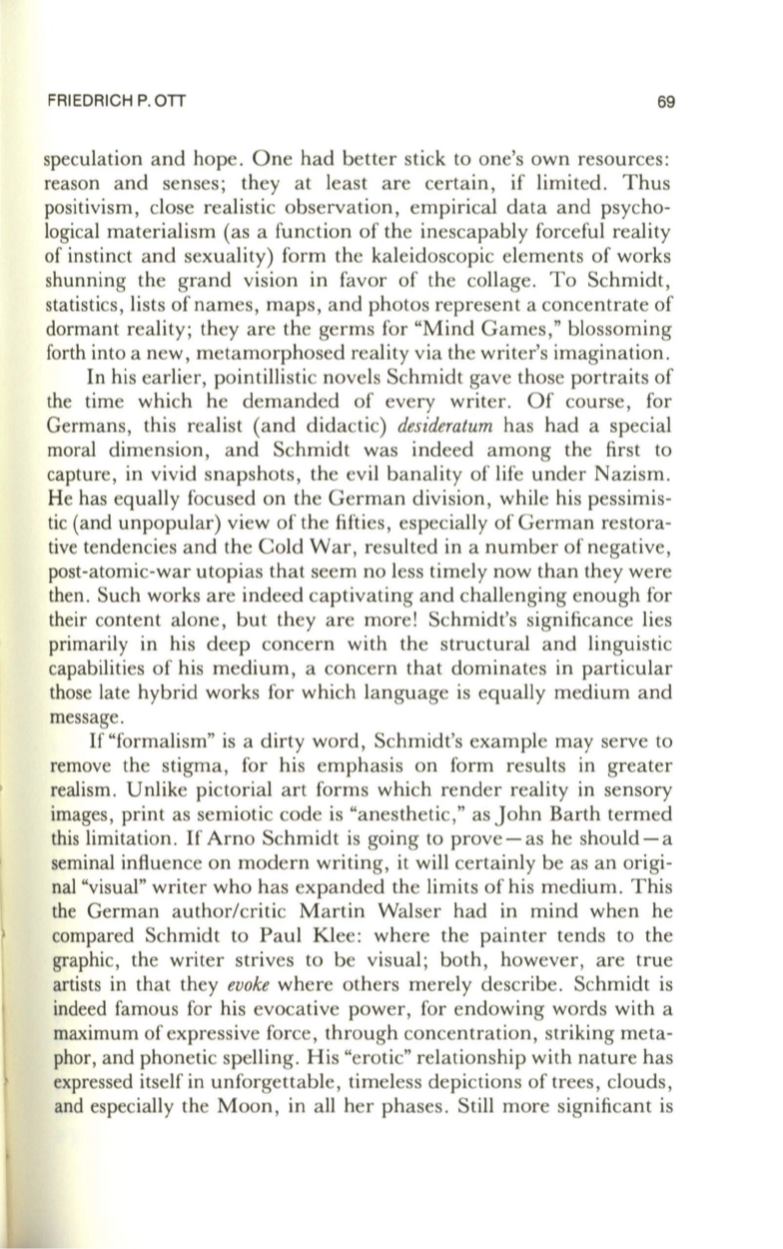
FRIEDRICH P. OTT
69
speculation and hope. One had better stick to one's own resources:
reason and senses; they at least are certain, if limited. Thus
positivism, close realistic observation, empirical data and psycho–
logical materialism (as a function of the inescapably forceful reality
of instinct and sexuality) form the kaleidoscopic elements of works
shunning the grand vision in favor of the collage. To Schmidt,
statistics, lists of names, maps, and photos represent a concentrate of
dormant reality; they are the germs for "Mind Games," blossoming
forth into a new, metamorphosed reality via the writer's imagination.
In his earlier, pointillistic novels Schmidt gave those portraits of
the time which he demanded of every writer. Of course, for
Germans, this realist (and didactic)
desideratum
has had a special
moral dimension, and Schmidt was indeed among the first to
capture, in vivid snapshots, the evil banality of life under Nazism.
He has equally focused on the German division, while his pessimis–
tic (and unpopular) view of the fifties, especially of German restora–
tive tendencies and the Cold War, resulted in a number of negative,
post-atomic-war utopias that seem no less timely now than they were
then. Such works are indeed captivating and challenging enough for
their content alone, but they are more! Schmidt's significance lies
primarily in his deep concern with the structural and linguistic
capabilities of his medium, a concern that dominates in particular
those late hybrid works for which language is equally medium and
message .
If
"formalism" is a dirty word, Schmidt's example may serve to
remove the stigma, for his emphasis on form results in greater
realism. Unlike pictorial art forms which render reality in sensory
images, print as semiotic code is "anesthetic," as John Barth termed
this limitation.
If
Arno Schmidt is going to prove - as he should - a
seminal influence on modern writing, it will certainly be as an origi–
nal "visual" writer who has expanded the limits of his medium. This
the German author/critic Martin Walser had in mind when he
compared Schmidt to Paul Klee: where the painter tends to the
graphic, the writer strives to be visual; both, however, are true
artists in that they
evoke
where others merely describe. Schmidt is
indeed famous for his evocative power, for endowing words with a
maximum of expressive force, through concentration, striking meta–
phor, and phonetic spelling. His "erotic" relationship with nature has
expressed itself in unforgettable, timeless depictions of trees, clouds,
and especially the Moon, in all her phases . Still more significant is


